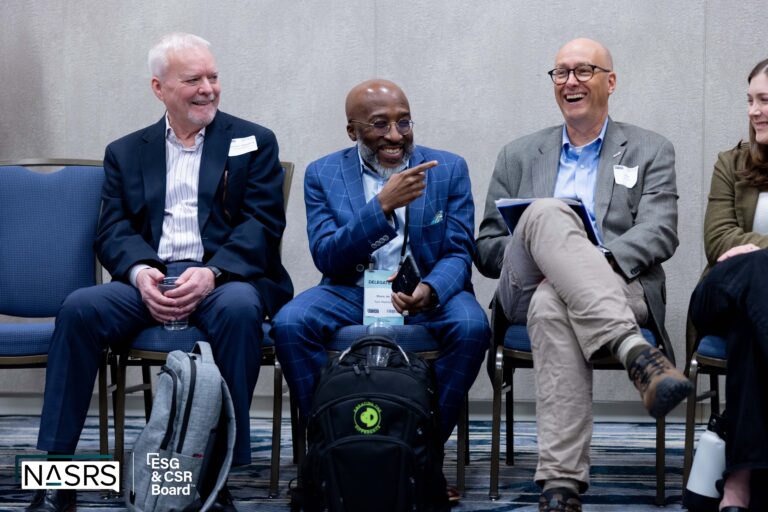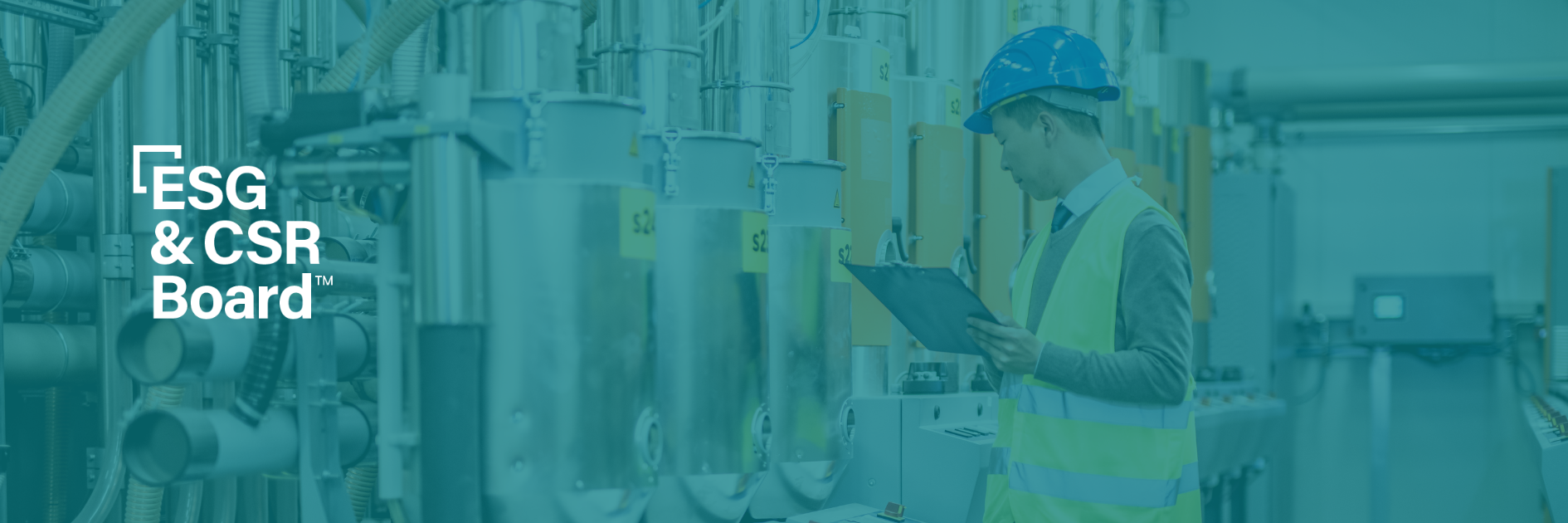If your company is involved in heavy industry, you know the pressure comes from every direction. One set of stakeholders is demanding aggressive decarbonization of complex, capital-intensive manufacturing processes. Another is pressuring you to scale back your sustainability commitments altogether. Meanwhile, your customers want more data, more disclosures, and more transparency — fast.
For sustainability leaders in manufacturing, the stakes are different. You’re trying to move massive, global operations in a more sustainable direction without disrupting the business or losing credibility internally.
That tension was the focus of a recent confidential ESG & CSR Board huddle, where sustainability leaders from industrial manufacturers gathered to discuss what it really looks like to lead ESG in this environment. Across companies and sectors, the challenges are strikingly consistent — but so are the strategies emerging to meet them.
Here are five hard truths these leaders shared and how they’re finding paths forward.
1. CSRD Is Driving a Flood of Customer ESG Data Requests
Several sustainability manufacturing leaders in the huddle pointed to regulations, primarily the EU’s Corporate Sustainability Reporting Directive (CSRD), as the most immediate pressure on their teams — though the recent delay tied to the Omnibus Directive may have given an illusion of relief.
One Director of ESG privately shared that their customer requests have gone through the roof triggered by CSRD, saying, “We’re now required to report all of these customer requests that are trying to align to the CSRD, and we’re not necessarily prepared for it.”
Customer-driven reporting requests are coming faster and with greater complexity, especially from global clients who are racing to meet their own compliance obligations.
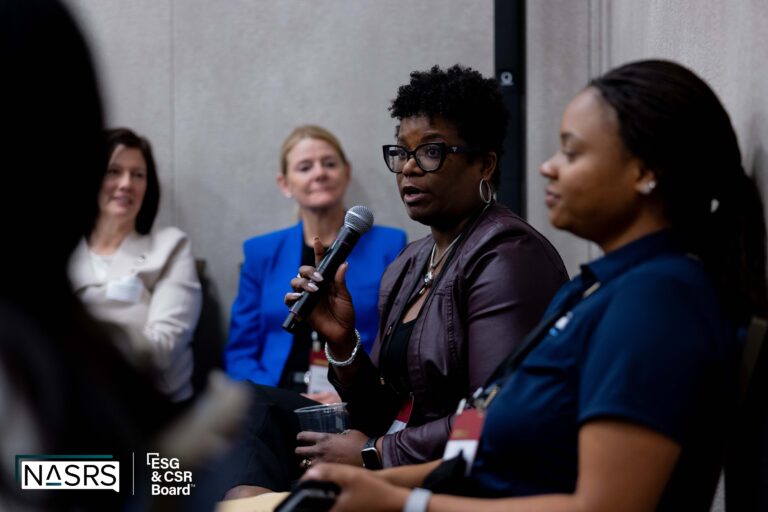
One leader said, “A lot of customers that we deal with, particularly in big tech, really do care about the performance of our products and what’s in our products. All this to say, the pressure is here.”
These demands span multiple geographies and often require product-level data that hasn’t historically been tracked or requires deeper collaboration across supply chains and business units.
One participant noted that their independent dealer network now regularly requests tailored sustainability disclosures. Another mentioned that their team is being pushed to engage more deeply with suppliers who aren’t yet clear on why the data is needed or don’t have the capacity to deliver it.
Plus, several leaders shared that they’re being asked to produce more with the same, or even fewer, resources. That’s forcing difficult tradeoffs around where to focus: digitizing systems and embracing artificial intelligence, upskilling internal teams, or attempting to standardize data across regional business units. And while automation is a priority, there’s a limit to how much progress can be made when headcount remains flat.
No one on the call claimed to have it fully figured out, but several shared practical strategies they’re pursuing to get ahead of rising data demands.
What’s Working: Early Moves to Build Resilience
- Invest in automation now, not later. One ESG leader said their team is using the CSRD delay to move away from ‘slamming spreadsheets together’ and toward digitized, scalable systems.
- Support suppliers, but set limits. One participant shared that they’re offering limited support to help their suppliers get up to speed on ESG data, but are cautious not to overextend internal resources.
- Get IT “at your hip.” As ESG data requirements increase, leaders emphasized the importance of partnering closely with internal IT teams. Several noted that current tools don’t yet reach deeply enough into the supply chain, so future-proofing platforms requires shared ownership with tech leaders from the start.
2. Making ESG Everyone’s Job Is Easier Said Than Done
Nearly every leader in the huddle agreed: for ESG to be truly effective in a manufacturing environment, it can’t sit in a silo. It has to be embedded in daily decision-making across teams. But driving that mindset shift is proving much harder than expected.
One ESG leader shared that reframing ESG as a business strategy — not a marketing message — has been their top priority. They’re working to socialize the idea that sustainability isn’t an add-on; it’s part of building a more efficient, future-ready company.
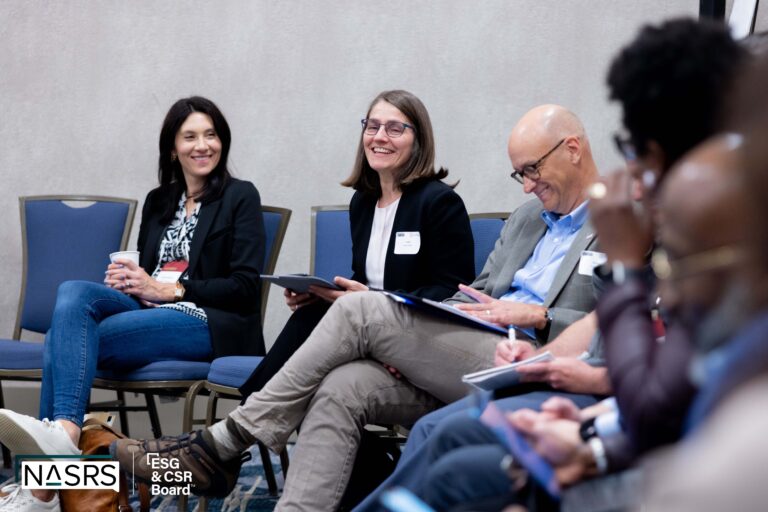
“One of the focuses that I have in my role is to ensure that our various levels within the organization understand that ESG is nothing more than their everyday work,” they said.
While product and engineering teams have generally embraced this integration, some leaders reported hitting unexpected resistance in operations, especially with Environmental, Health, and Safety (EHS) teams.
Others pointed out that EHS teams are stretched thin, especially in organizations managing serious safety risks across dozens, or even hundreds, of facilities. That makes it harder to layer in new sustainability responsibilities or shift long-established ways of working.
What’s Working: Getting ESG Into the Flow of Business
- Leverage operational efficiency goals. Several leaders said that aligning ESG with existing goals — like reducing waste or improving plant performance — helps secure buy-in from EHS and operations teams.
- Tailor the message by function. Sustainability means something different in engineering than it does in EHS or procurement. Leaders found more traction when they adjusted their messaging to reflect those nuances rather than pushing a one-size-fits-all definition of ESG.
- Build from early champions. In cases where product and engineering teams were already aligned with ESG goals, leaders used those teams as success stories.
3. Disconnected Systems Are Slowing Progress
As data demands increase, many ESG leaders at large manufacturers said their existing tools and systems are falling short — especially when it comes to supply chain visibility and scalability.
This lack of visibility is especially frustrating for teams already working to align with frameworks like CSRD, SBTi, or EU deforestation regulations. Even when suppliers are willing, there’s often no centralized way to gather or verify data across geographies and product lines.
Complicating matters, ESG leaders said they’re often expected to lead systems evaluations on their own without enough support from IT, procurement, or other key functions.
What’s Working: Laying the Groundwork for Better Systems
- Partner with IT early. Several leaders stressed that ESG can’t be the only team driving tool selection. Co-owning technology decisions with IT was seen as essential to ensure future integration and scalability.
- Evaluate tools through a supply chain lens. Off-the-shelf ESG platforms may be sufficient for corporate-level disclosures, but most fall short when applied to global, multi-tier supply chains. Leaders suggested pressure-testing tools specifically against supplier engagement and product-level data needs.
- Use CSRD prep to define requirements. Some teams are using the urgency of CSRD readiness as leverage to get cross-functional buy-in for new systems.
4. Prioritizing Capital for Decarbonization Means Tough Tradeoffs
Even with clear emissions data, several leaders said it’s hard to know where to invest first or how to balance decarbonization goals with customer expectations and business realities.
Many teams are still picking off low-hanging fruit. Others, especially those further along in their decarbonization journey, described the last 10–20% of emissions as being the hardest and most expensive to address.
For those whose emissions are concentrated in Scope 3, it’s even more complicated. In many cases, the suppliers responsible for the biggest impact aren’t mature enough in their own decarbonization efforts to meaningfully support a manufacturer’s net-zero goals.
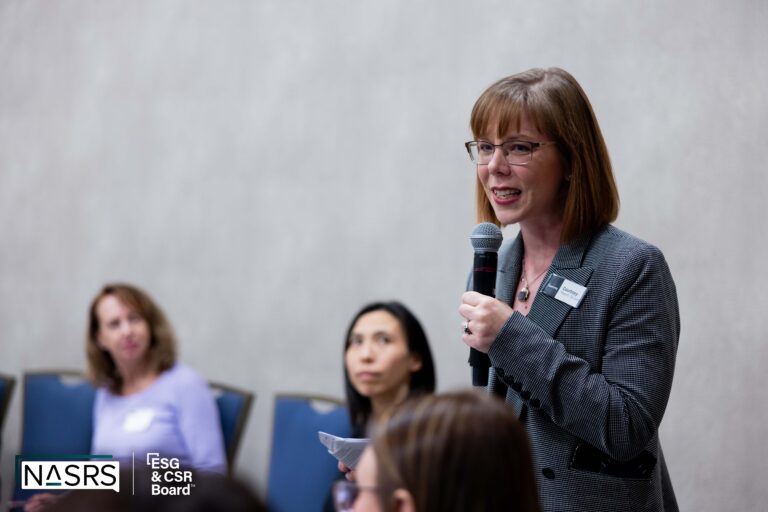
What’s Working: Making the Business Case for Decarbonization
- Link carbon reduction to capital planning. ESG leaders are partnering with productivity and engineering teams to integrate emissions reduction into capital project evaluations, putting sustainability benefits alongside financial ROI.
- Focus on product-level emissions first. Some teams are using customer demand for product carbon footprints as a way to prioritize investments that drive both business value and emissions reductions.
- Take an 80/20 approach. Some leaders are starting with the top 80% of emissions sources tied to core revenue-generating products and operations, where the impact and business alignment are clearest.
5. Communicating ESG Internally and Externally Is a High-Wire Act
Industrial manufacturers are navigating two competing realities: growing global demand for transparent ESG commitments and increasing political scrutiny, particularly in North America. That tension is reshaping how sustainability leaders talk about their work, both inside and outside the company.
Several leaders said they’ve adjusted their messaging by audience, and in some cases, dropped “ESG” from external reports altogether. One participant shared that they rewrote their company’s sustainability report five times to soften language and avoid drawing attention in politically sensitive regions.
Others described balancing the risk of saying too much with the risk of saying too little. With European competitors advancing their sustainability claims and CSRD compliance, holding back too much could mean falling behind in customer perception.
What’s Working: Striking the Right Messaging Balance
- Let materiality and values guide the message. One leader said tying ESG communication back to long-standing company values and materiality helped quiet internal resistance and keep messaging consistent even amid political turbulence.
- Use different language with different stakeholders. Internally, “sustainability” may resonate more than “ESG.” Externally, language is being carefully tailored by region and audience to avoid backlash while maintaining transparency.
- Train sales and comms teams. As one leader shared, European sales teams were eager to use “green” terminology, necessitating tight guardrails and shared messaging frameworks to ensure alignment and manage reputational risk.
The ESG & CSR Board isn’t just another professional network; it’s your competitive advantage.
The manufacturing ESG leaders in our recent huddle didn’t have all the answers, but they had something equally valuable: a room full of peers who understood exactly what they were up against.
Our confidential huddles bring together sustainability leaders from the world’s largest manufacturers to share what’s actually working without any vendors, agencies, or consultants. Because when CSRD compliance deadlines are quickly approaching and your customer data requests have tripled, you need more than best practices — you need battle-tested strategies from leaders who’ve already been there.
Apply now to join the ESG & CSR Board and gain access to the real-world peer insights industrial supply chain leaders rely on.
